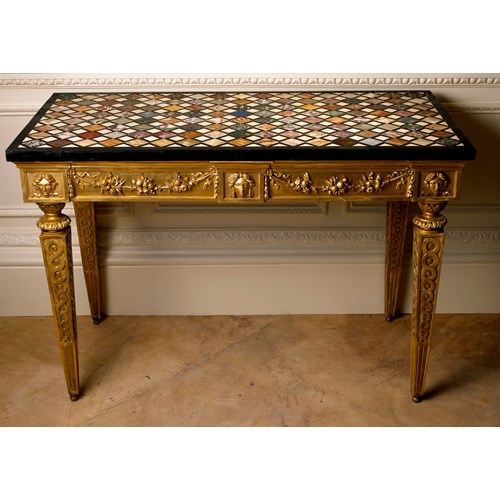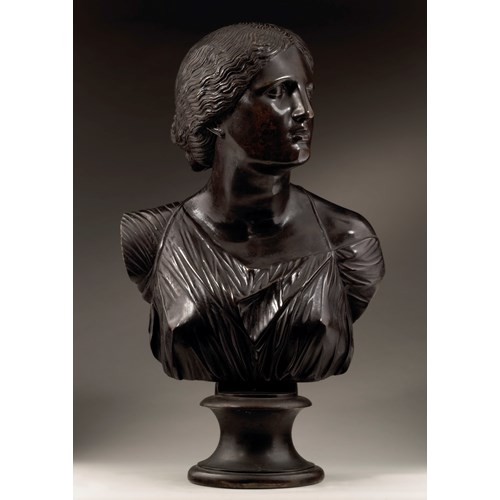Marketplace
Bust of a Nobleman in Armour
Giovacchino Fortini
Bust of a Nobleman in Armour
Date First half of the 18th century
Epoque 1600-1750, 18th century
Origine Italy, Florence
Medium White marble
Dimension 81 cm (31⁷/₈ inches)
Giovacchino Fortini rose to prominence at the same time as such masters as Giovanni Battista Foggini and Massimiliano Soldani Benzi. Fortini was an important protagonist and innovator who helped mark the passage from a majestic Baroque concept of statuary to a new and original language.
The precise design, elegant finish and decorative details combine with the mature and virile stance of the unknown sitter to proclaim the Florentine origin of this bust. In the early eighteenth century, Florentine sculptors produced incredibly individual portraits, with accents of sophistication, irony, and taste. In contrast to the exuberant symphonies in sculpture that Foggini produced, Fortini’s more refined technique allowed him to sculpt thinner, lighter forms which appear to be almost transparent and that throw delicate shadows across the surface of the marble. These qualities are exhibited in our bust as much as they are in Fortini’s other marble portraits and in his crisp terracotta models. For these reasons, Fortini’s work should be viewed as an exquisite representative of the modern current of Florentine sculpture in the eighteenth century. It is clear that our bust reflects the most recent stylistic developments at the Medici court of the time, as well as being in line with the international taste for monumental portrait sculpture.
The Medusa and the engraved decoration of the armour are clearly the products of an eccentric and wonderfully creative mind and is executed with a finesse reminiscent of the fine medals of the period produced by Massimiliano Soldani Benzi. Fortini also excelled at Medallic art and himself conceived some of the finest examples of the late Baroque Period. Similarly, in accordance with the great contemporary paintings of the period, the penetrating stare of the sitter evidences Fortini’s strong commitment to realism. Yet at the same time, this composition seems infused with a lyrical vein that allows this bust to transcend the official requirements of a work for obviously such a prestigious patron.
This richly expressive portrait bust is wrapped in a broad swathe of drapery which charges the figure with a commanding grandiosity that is extremely imposing and which conveys a sense of the sitter’s authority, status and power. Fortini’s genius can be seen in the way he manages to produce a rapturous, characteristically Baroque expression of vivacity and movement, whilst maintaining a sense of the sitter’s calm and commanding serenity.
We are grateful to Dr. Mara Visonà for her contribution towards the research on this piece.
RELATED LITERATURE:
S. Bellesi and M. Visonà, Giovacchino Fortini. Scultura Architettura decorazione e Committenza a Firenze al tempo degli ultimi Medici, 2 vols., Florence, 2008, II, nos. 14 and 16
The precise design, elegant finish and decorative details combine with the mature and virile stance of the unknown sitter to proclaim the Florentine origin of this bust. In the early eighteenth century, Florentine sculptors produced incredibly individual portraits, with accents of sophistication, irony, and taste. In contrast to the exuberant symphonies in sculpture that Foggini produced, Fortini’s more refined technique allowed him to sculpt thinner, lighter forms which appear to be almost transparent and that throw delicate shadows across the surface of the marble. These qualities are exhibited in our bust as much as they are in Fortini’s other marble portraits and in his crisp terracotta models. For these reasons, Fortini’s work should be viewed as an exquisite representative of the modern current of Florentine sculpture in the eighteenth century. It is clear that our bust reflects the most recent stylistic developments at the Medici court of the time, as well as being in line with the international taste for monumental portrait sculpture.
The Medusa and the engraved decoration of the armour are clearly the products of an eccentric and wonderfully creative mind and is executed with a finesse reminiscent of the fine medals of the period produced by Massimiliano Soldani Benzi. Fortini also excelled at Medallic art and himself conceived some of the finest examples of the late Baroque Period. Similarly, in accordance with the great contemporary paintings of the period, the penetrating stare of the sitter evidences Fortini’s strong commitment to realism. Yet at the same time, this composition seems infused with a lyrical vein that allows this bust to transcend the official requirements of a work for obviously such a prestigious patron.
This richly expressive portrait bust is wrapped in a broad swathe of drapery which charges the figure with a commanding grandiosity that is extremely imposing and which conveys a sense of the sitter’s authority, status and power. Fortini’s genius can be seen in the way he manages to produce a rapturous, characteristically Baroque expression of vivacity and movement, whilst maintaining a sense of the sitter’s calm and commanding serenity.
We are grateful to Dr. Mara Visonà for her contribution towards the research on this piece.
RELATED LITERATURE:
S. Bellesi and M. Visonà, Giovacchino Fortini. Scultura Architettura decorazione e Committenza a Firenze al tempo degli ultimi Medici, 2 vols., Florence, 2008, II, nos. 14 and 16
Date: First half of the 18th century
Epoque: 1600-1750, 18th century
Origine: Italy, Florence
Medium: White marble
Dimension: 81 cm (31⁷/₈ inches)
Provenance: Private collection, New York
Literature: RELATED LITERATURE:
S. Bellesi and M. Visonà, Giovacchino Fortini. Scultura Architettura decorazione e Committenza a Firenze al tempo
degli ultimi Medici, 2 vols., Florence, 2008, II, nos. 14 and 16
Plus d'œuvres d'art de la Galerie




 (Circle of)-Mirror_T638966768197244598.jpg?width=500&height=500&mode=pad&scale=both&qlt=90&format=jpg)


_T638968278933070912.jpg?width=500&height=500&mode=pad&scale=both&qlt=90&format=jpg)

